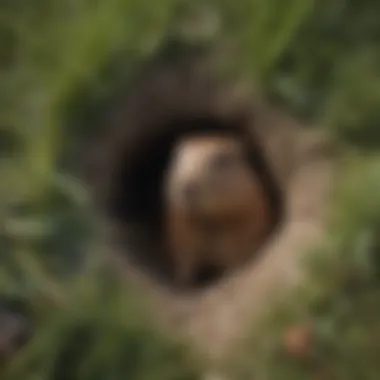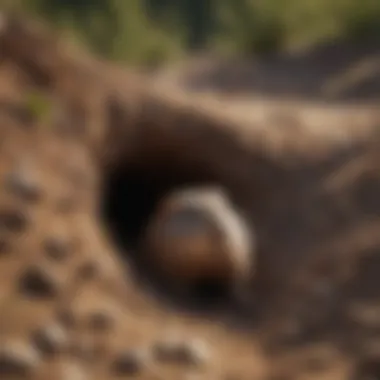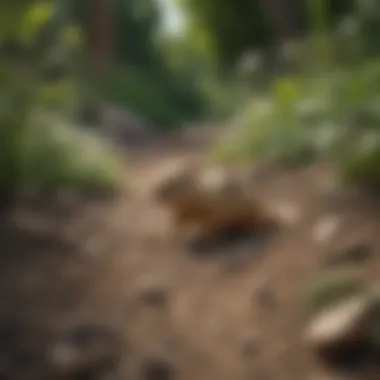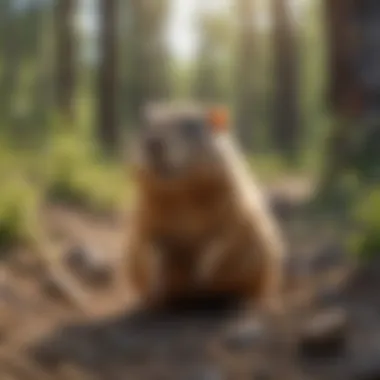Understanding Gopher Holes: Behavior and Management


Intro
Gophers, those small, burrowing rodents from the family Geomyidae, play a fascinating role in our ecosystems, particularly when they take up residence in our backyards. Encountering gopher holes might trigger frustration for some homeowners, while others may find a certain allure in the quirky behaviors of these elusive creatures. A deeper dive into their world reveals complexities that extend beyond mere nuisance. Understanding the implications of gopher holes in urban and suburban environments can guide homeowners on how best to manage these inhabitants while appreciating their ecological significance.
From the impact of their burrowing on the soil structure to their interactions with other wildlife, the presence of gophers invites us to consider our approach to coexistence and sustainability in the landscapes we nurture.
In the subsequent sections, we will explore various aspects including their species profile, behaviors, the impacts they have on our gardens, and our options for managing these pint-sized diggers. Whether you're a concerned homeowner, a nature enthusiast, or simply curious about the burrows in your yard, this exploration will shed light on these engaging creatures.
Preface to Gopher Presence
The presence of gophers in residential areas is more than just a curious oddity—it's a phenomenon worthy of exploration. Understanding gopher activity and how these small, burrowing mammals interact with our yards holds significant implications for homeowners, landscapers, and wildlife enthusiasts alike. Most people might view gophers simply as pests, but a deeper exploration reveals their profound impact on local ecosystems.
First off, let's talk about the importance of recognizing gopher holes. These mounds of dirt aren't just unsightly; they signify active burrowing that can affect the composition of the soil. Homeowners must appreciate how these tunnels contribute to soil aeration, an often underestimated benefit. Aerated soil promotes plant health by allowing air and water to reach deep roots, ultimately enhancing the overall vigor of a garden or lawn.
Moreover, acknowledging gopher presence also helps in making informed landscaping choices. It's crucial for homeowners to grasp how gophers may inadvertently shape their gardens. Learning about their behavior can prompt strategies to coexist peacefully, minimizing unwanted disruption.
"Gophers play a role in shaping the ecological landscape, even in urban settings. Recognizing their importance allows for a more harmonious relationship with nature."
This article establishes a foundation for understanding gopher activity, from basic definitions to practical management techniques. By taking the time to explore these aspects, readers will find themselves equipped with the knowledge to live alongside gophers without unnecessary struggle, ultimately encouraging biodiversity in their yards.
In summary, delving into the nature of gophers offers valuable insights that not only enrich our gardens but enhance our connection with the environment around us. Let's delve deeper into the specifics of these intriguing creatures.
Anatomy of Gopher Holes
Understanding the anatomy of gopher holes is essential for comprehending how these creatures interact with their environment and what that means for homeowners. Gopher burrows are not merely nuisances; they serve crucial ecological functions. Their designs influence soil composition and contribute to a vibrant ecosystem. Recognizing these details helps us appreciate the fine balance of our yard's ecosystem while also spotting any potential drawbacks that gophers might bring.
Structure of Burrows
Gopher tunnels can be quite extensive, often stretching out in a complex system beneath the surface. A single gopher can create a labyrinth of burrows that span over hundreds of yards. Each burrow is typically about two to three inches in diameter and varies in depth. In general, the structure involves two main types of tunnels:
- Main tunnels: These primary passages are horizontal, usually positioned just below the surface. They lead to various chambers for food storage and nesting.
- Exploratory tunnels: These are less stable and can connect to other burrow systems. They allow gophers to forage for roots and seeds, effectively expanding their reach.
The chambers within these tunnels serve multiple purposes:
- Nesting space: Gophers create a comfortable place to raise their young, lined with soft materials like grass and leaves.
- Food storage: They often stash edibles like bulbs and roots, showing a proclivity for hoarding.
- Waste disposal: Gophers also have a designated area for their waste, keeping their living spaces relatively clean.
The stability of these burrows is surprising; they can withstand a good amount of rain and even foot traffic above. However, constant disturbance can lead to collapse, potentially harming the gopher community by blocking escape routes.
Signs of Active Burrowing
Spotting gopher activity in your yard primarily hinges on visual clues. Gopher holes often feature distinct mounds of soil, which can look like miniature volcanoes scattered across the landscape. These mounds—typically around 10 to 12 inches in diameter—indicate a burrowing event, as gophers push soil to the surface when digging out new tunnels.
Here are key indicators of continued gopher activity:
- Freshly dug mounds: New soil with a darker hue indicates recent work. Older mounds may be overgrown with grass or debris.
- Plant damage: Look for wilting or uprooted plants near the mounds. Gophers love munching on roots, leading to visible destruction in your garden.
- New tunnel entrances: If you can see straight, clear openings to the burrows, it implies that the gopher is actively using that pathway.
"Gopher holes may seem like a nuisance, but their presence indicates a rich and dynamic ecosystem at play underneath the surface."


The telltale signs of gopher activity can compel homeowners to take actions, whether it’s to protect their cherished gardens or simply to enjoy observing these vivacious little builders at work.
Ecological Role of Gopher Activity
Gophers hold a peculiar place in the natural order of things, acting as unseen engineers of their environment. Their burrowing habits, often viewed as nuisances by homeowners, can be crucial for maintaining the ecological balance in suburban areas. By digging through soil, gophers are not just creating a mess in gardens; they are impacting the habitat significantly. This section delves into the beneficial roles that gopher activity plays, specifically in soil aeration and the overall health of local flora.
Soil Aeration Benefits
When gophers burrow underground, they create extensive tunnel systems. This action effectively aerates the soil, allowing air, water, and nutrients to circulate more freely. As they dig, they break apart compacted earth, which otherwise would restrict root growth for many plants. Imagine trying to hold your breath while running a marathon— that's what roots face in compacted soil!
- Enhanced Drainage: The tunnels formed by gophers help prevent waterlogging during heavy rainfall. Water can seep through these channels instead of pooling on the surface.
- Nutrient Redistribution: As gophers move through the soil layers, they mix organic matter, helping to bring nutrient-rich materials closer to the surface where plants can access them more easily.
- Microbial Activity: The presence of gopher tunnels increases microbial activity, which is essential for soil fertility. Enhanced microbial life aids in breaking down organic materials, making nutrients available to plants.
Gophers, in this sense, are not just pests but vital contributors to the soil's health. Providing aeration can significantly uplift the quality of garden soil, leading to more robust plant growth. While they may seem bothersome, clods of earth disturbed by gopher activity can actually be a sign of enhanced soil health.
Impact on Local Flora
Gopher activities extend beyond their burrows and contribute to a diverse ecosystem. Their foraging habits influence plant communities, making room for certain species while controlling others. Here are a few aspects of how they interact with local vegetation:
- Seed Dispersal: Gophers often collect seeds, inadvertently dispersing them throughout their territory. This behavior fosters plant diversity, as new growth can occur away from the parent plant, which tends to have its own set of environmental stresses.
- Fostering Growth: Some plants thrive in disturbed soil. By burrowing, gophers create patches where sunlight reaches the ground, encouraging the growth of beneficial plants like wildflowers and native grasses.
- Control of Invasive Species: Gophers may inadvertently prevent the spread of invasive species by uprooting them or altering the soil's composition in ways that favor native flora.
“Gophers, as odd as it sounds, play the role of a gardener in their habitat, helping manage the delicate balance of local ecosystems.”
The relationship between gophers and flora is intricate, demonstrating the interdependence of species in any ecosystem. Understanding these dynamics allows homeowners to appreciate the natural functions of gophers beyond their reputation as mere nuisances, enriching the narrative of backyard ecology and its diverse inhabitants.
The Challenge of Gopher Holes in Yards
Managing gopher holes in residential backyards can be quite a headache for many homeowners. The challenge stems not just from the visual mess they create but also from the potential repercussions these burrowing creatures bring to landscapes and the safety of family members. It's essential to understand that while gophers contribute positively to soil health, their activities can have unintended consequences.
Their burrowing behavior and the holes they leave behind can lead to unsightly patches in yards, damaging gardens, lawns, and ornamental plants. It can pose a real dilemma: How can one appreciate the ecological roles of these animals while simultaneously tackling the mess they make in our domestic spaces?
"Encountering gopher holes is like a double-edged sword; on one side, they aerate soil, yet their impact can be destructive on the other."
This section digs deep into the specific challenges gopher holes present, starting with how they affect landscaping and then addressing the risks they pose not only to pets but also to young children.
Potential Damage to Landscaping
Gophers can wreak havoc on gardens and landscaping efforts. They make extensive burrow systems, often leading to the destruction of plant roots and the destabilization of soil. When these pests feast on the roots of valuable plants, it can result in wilting, yellowing, and even death of affected plants. Homeowners may find that their beautiful flower beds and vegetable patches can quickly turn into a graveyard of dead plants.
Key damages can include:
- Uneven Soil: The creation of holes leads to an uneven surface, which may hinder mowing and walking through the yard without tripping.
- Root Damage: Plants get uprooted as gophers dig. They often go for the roots, leading to significant losses in prized flora.
- Erosion Risks: With soil disrupted, there’s a higher chance of erosion during heavy rains, causing sediment displacement and potential runoff issues.
Addressing these challenges requires a balance of strategies aimed more at prevention than reaction. While it may be tempting to simply fill holes, a long-term plan that focuses on the underlying issue of attraction to your yard is critical.
Risks to Pets and Children
Aside from the aesthetic and ecological concerns, the risks gopher holes pose to pets and children cannot be ignored. These holes can create not only tripping hazards but also injuries. Pets, especially rambunctious dogs or curious cats, may find themselves in a tight spot should they happen to stumble into a gopher hole, potentially causing sprains or falls.
For children, unmonitored play in the yard increases the risk of accidents related to uneven ground or concealed holes. Moreover, while gophers themselves are not typically aggressive, the possibility of encountering wildlife due to disturbed burrows poses a risk. It's prudent to keep an eye on little ones and furry friends while they explore the outdoors.


Some considerations for safety include:
- Regular inspections: Keep an eye on the yard, especially after heavy rains that might have revealed new holes.
- Training pets: Teaching pets to avoid certain areas can be beneficial.
- Clear play areas: Designate safe zones in your yard, free from gopher activity.
By grasping these challenges posed by gopher holes in yards, homeowners can navigate the complexities of coexistence with these critters while safeguarding their residential spaces and ensuring the safety of those they cherish.
Management Strategies for Homeowners
Managing gopher holes in your yard can be quite the undertaking, especially for those who cherish their landscaping and love a well-kept garden. Effectively dealing with these burrowing critters requires a comprehensive approach. The goal isn’t just to eliminate gophers but to find a way to coexist with them while ensuring the integrity of your outdoor space. Here, we will specifically touch on habitat modifications, utilizing natural predators, and human-compatible deterrents that can be beneficial for homeowners.
Habitat Modification Techniques
One of the most logical steps you can take toward managing gopher activity is making small adjustments to your yard. This begins with understanding what gophers find appealing. Their ideal environment consists of soft soil, abundant underground food sources, and suitable cover. Here are some straightforward strategies:
- Soil Composition: Gophers prefer loose, sandy soil that allows them to easily dig. By adding clay or compacted earth, you can create conditions less favorable for tunneling.
- Plant Choices: Consider what you plant. Certain flowers or vegetables are like a banquet for gophers. Some plants, like daffodils, lavender, or onion family types, are less appealing to these rodents. Planting such species around the perimeter might deter them from entering your main garden.
- Mulching and Ground Cover: Using thick layers of mulch may not only enhance your garden aesthetically but also act as a barrier that gophers find difficult to traverse. Ground cover plants, especially those that form dense mats, could help mitigate tunneling.
"Natural landscapes can sometimes be disrupted by simple changes in your own yard. Awareness can make all the difference."
Utilizing Natural Predators
Leveraging the natural order can be a non-invasive and effective way to manage gopher populations. Introducing or attracting natural predators is one way to keep these rodents in check. Here are a few common predators and helpful tricks to invite them:
- Owls: Barn owls are voracious gopher eaters. Installing owl boxes can attract them to your yard. They appreciate dark and quiet places to perch.
- Hawks: Like owls, hawks enjoy open spaces to hunt. Creating a suitable area with perches can encourage them to patrol your yard.
- Snakes: While not everyone's favorite, snakes are another natural control. Emphasizing a wildlife-friendly environment can invite them. Ensuring there’s ample cover like brush piles can be beneficial.
Finding that balance between inviting wildlife and protecting your garden is key. Not all predatory friends will harm your plants, and many will do the work of managing pesky gophers.
Human-Compatible Deterrents
If you've tried modifying your habitat and encouraging predators with little success, consider employing humane deterrents. Options exist that are less harmful and still yield results. Here are some to explore:
- Noise-Making Devices: Many homeowners have had luck with devices that emit sounds to disturb gophers. These devices operate on the principle that gophers perceive certain frequencies as threatening.
- Scent Deterrents: Using natural scents can be a good option. Smells like castor oil or hot pepper can discourage gophers from making their home in your yard. It’s always beneficial to test small areas first.
- Barrier Systems: Installing physical barriers, such as gopher wire or grating beneath the soil in new plantings, can help prevent gophers from accessing roots. Think of it as a fence for your flowers without intruding on the natural environment.
Adopting these approaches requires thoughtfulness and trial and error. Regardless of the methods chosen, the consensus is that a thoughtful combination often proves to be the most effective strategy to manage gopher holes in your yard.
Preventive Measures to Avoid Gopher Infestations
Understanding how to effectively deter gophers from burrowing in your yard is crucial for maintaining an aesthetically pleasing and functional outdoor space. Gophers can wreak havoc on gardens and lawns, leading to unsightly holes and potential damage to plant roots. Hence, preventive measures are beneficial not just for keeping gophers at bay, but also for promoting a healthy and vibrant yard.
Proper Landscaping Choices
Making the right landscaping decisions is fundamental in discouraging gopher activity. Certain plants are more appealing to gophers, while others can act as natural deterrents. Here are some landscaping strategies to consider:
- Choose Native Plants: Native plants are often more resilient in local ecosystems and may be less attractive to gophers. Research which plants thrive in your area and incorporate them into your landscape design.
- Avoid Bulbs and Tubers: Gophers are particularly fond of plants with extensive root systems, like tulips or potatoes. Instead, opt for plants that have evolved defenses against such critters.
- Barrier Methods: Installing underground barriers, such as wire mesh or hardware cloth, around sensitive flower beds can deter gophers from accessing them. Make sure to bury the material at least a foot deep to provide effective obstacle.
- Mound Construction: Shaping your garden beds into raised mounds can disrupt gopher movement while also providing better drainage, which is often desirable for many plants.
These landscaping choices may require a little extra thought and planning, but they contribute to a sustainable environment that's less inviting for gophers.
Maintaining Soil Health


Healthy soil not only supports plant growth but can also help manage gopher populations. Here are a few practices:
- Regular Aeration: Aerating your soil on a routine basis can disrupt gopher tunneling and encourage healthy root growth for your plants. Additionally, it improves water penetration and nutrient distribution.
- Encourage Natural Predators: Maintaining an ecosystem that is rich in native wildlife can help balance pest populations. Owls, hawks, and snakes may predate on gophers, providing a natural control method.
- Soil Enrichment: Avoid excessive use of chemical fertilizers. Healthy, organic soil populated by diverse microorganisms often produces strong plants that are less susceptible to gopher damage. Consider using compost or natural mulch to improve soil quality.
- Keep the Area Clean: Clean up fallen fruit, seeds, or debris that may attract gophers. Ensuring your yard is free of potential food sources is a proactive way to discourage these critters.
By focusing on soil health, you not only create a more inviting environment for plants but also discourage gopher infestations.
"An ounce of prevention is worth a pound of cure." - Benjamin Franklin
Implementing these preventive measures can lessen the chances of gopher infestations in your yard, allowing homeowners to enjoy their gardens without unwarranted loss.
Legal and Ethical Considerations
Understanding the legal and ethical dimensions surrounding gopher management is crucial for responsible stewardship of our environment. These small mammals, while often regarded as pests by homeowners, are also integral components of our local ecosystems. Proper knowledge of the regulations that govern wildlife management helps in ensuring that both gophers and human interests coexist harmoniously.
Understanding Local Wildlife Laws
Local wildlife laws vary by region, but they generally aim to protect native species and their habitats. Many areas have specific regulations that dictate how to manage or control wildlife populations, including gophers. For instance, it might be illegal to kill gophers without proper permits or to use certain traps that might harm non-target species.
Homeowners should first familiarize themselves with these laws before taking action. Ignorance of regulations could lead to fines or further environmental harm.
- Key Considerations:
- Research on the intended local laws can be done at websites like Wikipedia or local wildlife agencies.
- Understanding the ecosystem role of gophers may lead to more humane and effective management solutions.
Keeping abreast of these regulations can also help homeowners implement safer practices for both the garden and local wildlife.
Ethical Approaches to Management
When dealing with gopher populations, ethical considerations should be front and center. The goal isn’t merely to eradicate a perceived nuisance, but to find solutions that respect the animal's role in the ecosystem.
An ethical approach could include:
- Humane Traps: Using traps designed to capture gophers without causing harm allows for relocation, should it be legally sanctioned.
- Monitoring: Keeping a close eye on gopher activity helps in deciding when intervention is really necessary. This allows for a more measured approach that prioritizes coexistence over eradication.
- Education and Advocacy: Homeowners can also work towards building awareness about the ecological benefits of gophers. For example, their burrowing can aerate soil, promoting healthier gardens. Advocacy for coexistence can foster a more positive relationship between humans and wildlife.
In summary, embracing ethical management strategies leads to a win-win; homeowners protect their interests without causing undue suffering or harm to gophers. As we navigate these considerations, it becomes evident that informed action fosters a healthier environment for all parties involved.
Culmination
Understanding the presence of gopher holes in your yard is more than just a matter of aesthetics or nuisance; it's integral to appreciating the intricate balance of our ecosystems. This article sheds light on various aspects of gopher behavior, their ecological roles, and practical strategies homeowners can adopt. It emphasizes that while gophers can pose challenges, they are also vital contributors to soil health and biodiversity.
Final Thoughts on Living with Gophers
Living with gophers requires a shift in mindset. Instead of viewing them strictly as pests, consider their role as agents of soil aeration and fertility. They can enhance plant growth and support overall ecosystem health. As annoying as their digging might be when it disrupts your lawn or garden, remember that not every gopher incident needs an aggressive response.
Engaging with their presence means choosing a balanced approach. Maybe you’ll learn to love your gopher buddies or, at the very least, figure out a workable coexistence strategy. They are resourceful critters who were here long before us, and their tenacity is a testament to their adaptability. Don't rush to declare war on them; instead, reflect on how they fit into the larger picture of your yard's ecosystem.
Encouraging Biodiversity
Encouraging biodiversity is an essential element of sustainable gardening and ecosystem management. Gophers play a crucial role in the food web. Beneficial insects and plants flourish in environments enriched by the soil aeration they provide. Their burrows also create habitats for numerous critters and earthworms that are vital for a healthy garden.
To promote biodiversity:
- Incorporate native plants: These plants are often more resilient and can adapt better to local soil and climate conditions. Native flora can thrive around gopher holes, leveraging the soil aeration for healthier growth.
- Create a wildlife-friendly garden: Develop spaces that invite various species, from birds to pollinators. This diversity adds layers to your garden and makes it less appealing to gophers, which prefer monocultures that give them easier access to edible roots.
- Educate your community: Sharing knowledge about gophers and their ecological significance can foster a greater appreciation for them among neighbors. Community involvement can lead to collaborative strategies that are beneficial for both your yards and the local environment.
The presence of gophers in residential areas prompts us to reflect on the interdependencies within our ecosystems. Their burrowing activities, while occasionally troublesome, lead to greater soil health, which benefits a myriad of other plants and animals.







